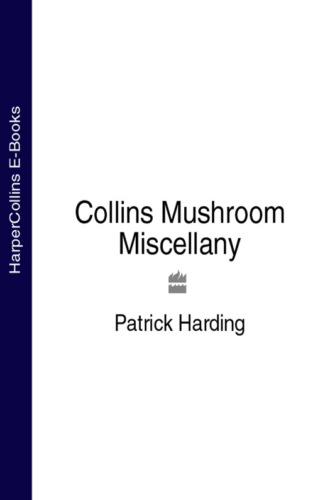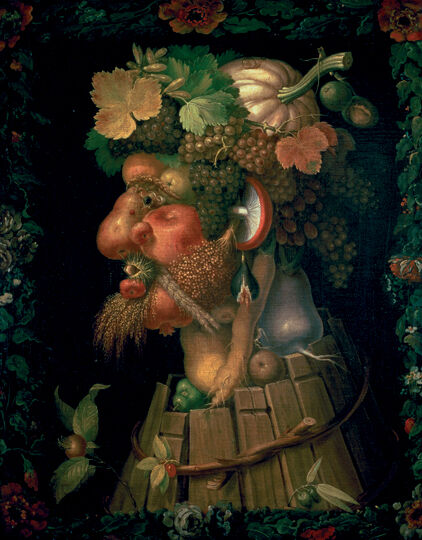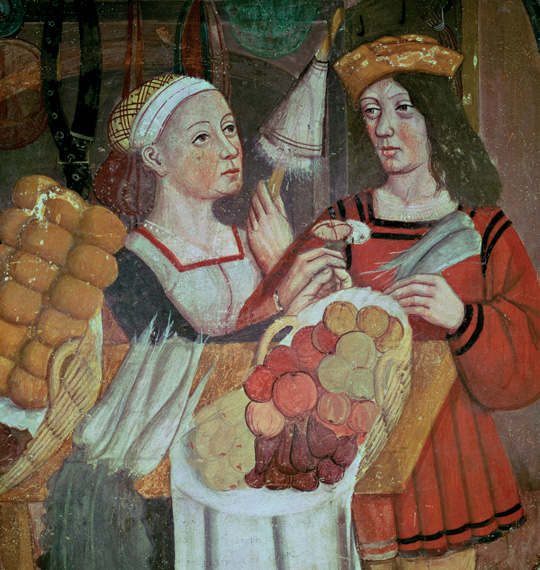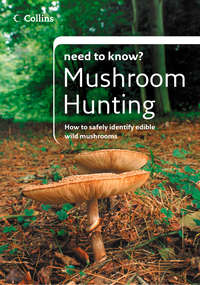
Полная версия
Collins Mushroom Miscellany



Autumn: oil on canvas (1573) by Giuseppe Arcimboldo
{Lauros/Giraudon/The Bridgeman Art Library (BAL)}
Dedication
I dedicate this book to Chloe, my ancient Jack Russell. Much of the book was planned during our daily walks together. I am also indebted to my nieces Charlotte and Sarah for their valuable comments and corrections at the manuscript stage. Finally thanks to my wife Jean and daughter Bryony for putting up with me while I was writing the book and good luck to my son Martin who sensibly moved out before I started.
Contents
Cover
Title Page
Dedication
1 No Ceps Please, We’re British
2 Mushrooms or Toadstools?
3 The Fifth Kingdom
4 How Many Are there?
5 Fungi, Folders and Files
6 The Shock of the New
7 Climate Change
8 The Names they are a-Changing
9 Where do Fungi Live?
10 Getting to the Root of the Matter
11 Mushrooms and Woodchips
12 Of Rings and things
13 How Old is a Mushroom?
14 Big is Beautiful
15 Mushroom Cultivation
16 Cultivating and Collecting Exotics
17 Truffles
18 Of Ballerinas and Ancient Oaks
19 A Code of Conduct for Mushroom Hunters
20 Fungi that Glow in the Dark
21 A Plague Upon your House
22 Not So Sweet As It Sounds
23 Boring Beetles and the Elm Decline
24 A Fungal Flasher
25 A Word in your Ear
26 Tippler’s Bane
27 Crockery on the Beach
28 All in the Name
29 St Anthony’s Fire
30 Mushroom Magic
31 A Toadstool is Spotted
32 Fungi on the Hoof
33 Love It or Hate It
34 Mycelial Meals
35 Medicinal Moulds
36 M.C.C.
37 Boletes to Bunnies
38 Poetry, Prose, Pop and Pictures
Keep Reading
Further Information
Bibliography
Index
Copyright
About the Publisher
No Ceps Please, We’re British

Boletus edulis (early 19th century) by Paul Louis Oudart
(Archives Charmet/BAL)
In the autumn of 1981 I taught my first residential weekend course on Mushrooms and Toadstools. On the Friday evening the small group of participants joined me for a preprandial drink. It was not long before I discovered that each of them had a similar tale to tell. The stories all included accounts of the jaw-dropping response of family and colleagues when told of the reason for their weekend away. In those days very few shops stocked anything other than white cultivated mushrooms which were usually neatly displayed in blue cardboard punnets. Field and other ‘wild’ mushrooms were largely left alone.
As for those people who collected and ate ‘toadstools’, they were considered to be either wildly eccentric or of European extraction. I was placed in the former category when, in 1983, The Guardian Diary section included a preview of seasonal entertainments offered by the Youth Hostel Association:
Curiosities like a voodoo evening at Boggle Hole in Robin Hood’s Bay are available, or an Esperanto weekend in the Peak District. First prize for an offbeat break, though, must go to the ‘fungus foray’ based at Edale on the weekend of October 7th–9th. For an extra £6 you can join mycologist Dr Patrick Harding collecting blewits, chanterelles and boletus [sic] edulis and consuming them in a ‘fungus feast’.
Five years later I was invited to teach a mushroom course on behalf of Cambridge University’s Adult Education Department, based at Madingley Hall. The silver service dinner on the Friday was preceded by a resonant gong and full Latin grace. Prior to the coffee, the warden addressed the assembled company:
Welcome to Madingley and to a fascinating range of weekend courses. ‘Unexplored Mozart’ will take place in the Saloon; those ‘Reading Greek’ will be in the Library while ‘Mushrooms and Toadstools’ will be …
Her voice was drowned by the rising tide of laughter from the musicians and linguists as I tried to appear invisible. By the Saturday evening I had recovered my composure and made my own announcement before the coffee was served:
Those of you studying Mozart and Greek are more than welcome to pay a brief visit to the board room, where you might be interested to see what those on the Mushroom course have been up to.
Spread across eight tables were scores of labelled specimens collected on our field trip. Two years later, when the course was repeated, I was delighted to welcome among the course members two from the Greek and three from the Mozart group. Twenty years on and the mushroom course is still running. It is heavily oversubscribed.
Mushroom hunters of European extraction included Polish immigrants who had settled in Britain during and immediately after World War II. Collecting and eating fungi is an important part of Polish culture and those in the vanguard of the more recent influx must have been pleasantly surprised by the lack of local competition when it came to mushroom hunting. A Polish dish traditionally served on Christmas Eve includes Boletus edulis in the list of ingredients.
Old English books about cookery and mushrooms mentioned Boletus edulis under its local name of penny bun. This moniker arose on account of the likeness of the pale-brown, slightly sticky, convex cap to a product displayed in many bakers and which had originally sold for just one (old) penny. In the years following World War II the bakers’ penny bun lost its fight against inflation while the mushroom lost the battle to keep its old English name. As British cooks looked for inspiration from French cuisine so the writers of cookery books anglicised the French name for the fungus Cèpe and penny bun became known as cep.
British cooks have rarely suffered from a shortage of recipe books; if anything the problem has been more one of surfeit rather than deficiency. The same cannot be said of books about mushrooms and toadstools; although like buses, after a long wait, several turned up at once. Lack of interest in edible mushrooms has long bordered on a phobia in Britain; a condition not helped by a paucity of non-technical books aimed at the general public.
Mordecai Cooke did his best in Victorian times with publications such as British Edible Fungi – How to Distinguish and to Cook Them. The British Government’s attempts to encourage fungal foraging, especially during times of food shortage, resulted in Edible and Poisonous Fungi – Bulletin No 23 of the Ministry of Agriculture and Fisheries, first published in 1910. This slim booklet described just 19 edible ‘varieties’ and nine poisonous ones. The remaining stock of the 1945 edition was destroyed by a German incendiary bomb, which may have been a blessing in disguise given that one of the species included in the edible section has since proved to be poisonous, albeit it to a minority of the population.
In the 1960s Findlay’s Wayside and Woodland Fungi included some illustrations by Beatrix Potter (see here), but the book was not aimed at those with a culinary interest in the subject. Richard Mabey’s ground-breaking Food for Free, first published in 1972, included a section on edible fungi. Three years later Jane Grigson produced her culinary classic, The Mushroom Feast, although with only limited mycological information and rather small line drawings. In the same year Shirley Conran included the following advice in Superwoman:
I’d rather lie on a sofa than sweep beneath it.
Life is too short to stuff a mushroom.
At the time the only widely available picture book aimed at the interested amateur, with the exception of The Observer’s book, was Lange and Hora’s Collins Guide to Mushrooms and Toadstools. As a young naturalist I ‘bagged’ my first 100 species with the help of Lange and Hora, but the quality of the pictures left much to be desired and no English names were included.
In 1981 Roger Phillips paved the way for the interested amateur mycologist with a user-friendly book (recently updated) adorned with excellent photographs and lightened by the inclusion of some English names. By 1986 Britain was almost ready for How to Identify Edible Mushrooms, which I wrote with my great friend Tony Lyon. The book is still in print and has been joined by a plethora of others (including Need to Know? Mushroom Hunting, published in 2006) on the subject of edible fungi.
For many years local natural history societies paid lip service to fungi with just a single annual foray, but following the upsurge of interest in mycology many groups now have a separate fungal section. In addition, since the 1990s many local fungal recording groups have been formed (see here for details) while journals such as Field Mycology and British Wildlife keep mycologists up to date with new developments. An interest in fungi is no longer considered unusual; penny buns have become accepted.
Mushrooms or Toadstools?

The Vegetable Market: detail from 15th Century Italian fresco
(Giraudon/BAL)
The Grete Herbal, written in 1526, had this to say about what it called ‘mussherons’:
There be two manners of them, one manner is deedly and sleath them that eateth of them and be called tode stoles.
Given that the other ‘manners’ were the edible ones, it is interesting to note that this indicates that the group of organisms termed mussherons (mushrooms) included the poisonous tode stoles (toadstools). Over the following 400 years the word mushroom came to be restricted to edible species, separate from the inedible toadstools, although it was realised that not all of the latter were poisonous. The title of Edward Step’s early 20th century book Toadstools and Mushrooms of the Countryside is indicative of the use of the two terms at a time when the common names of edible, if unrelated, species included field mushroom, parasol mushroom and oyster mushroom.
The meaning of the two terms continued in this way until the end of the 20th century, as evident in Gem Mushrooms and Toadstools (1996). As the British public became more interested in fungi and in gathering edible ones, so a subtle change occurred. The second edition of the Gem book appeared under the simpler title of Mushrooms, as did an updated version of a book by Roger Phillips previously entitled Mushrooms and Other Fungi of Great Britain and Europe. After almost 500 years the word mushroom has once again become an all-embracing term for the macrofungi (those that produce fruitbodies that can easily be seen with the naked eye); a group that includes the toadstools.
Scientists also lumped mushrooms and toadstools together, in a group known as the Agaricales. The ‘agarics’, as they became known, include all species with a fleshy, umbrella-shaped fruitbody as typified by fly agaric (Amanita muscaria), the infamous red and white toadstool. As knowledge of fungi developed, the agarics were separated into a large number of different genera, each containing closely related species. Professional mycologists reserve the word mushroom for members of the genus Agaricus, which have free gills (not attached to the stem), a ring on the stem and dark-brown spores shed from pink gills. The genus includes cultivated mushroom (Agaricus bisporus), field mushroom (Agaricus campestris) and yellow-staining mushroom (Agaricus xanthodermus). Unfortunately, not all members of the genus are safe to eat; Agaricus xanthodermus is mildly poisonous. One result of this is the enigma of a poisonous ‘mushroom’, one reason why the recent list of recommended English names (see here) drops the mushroom name in favour of yellow stainer.
If the terms mushroom and toadstool are confusingly interchangeable, the presumed etymology of the two words is equally complex. Several 19th century authors assumed that the word mushroom evolved from mussheron, which came from a French word, mouscheron. This was believed to be a derivation of mouche-eron, from an old French name for fly agaric (Amanita muscaria), which is most people’s idea of a toadstool rather than a mushroom. Other writers have attempted to make a link with the French word mousseron, still used in reference to certain edible fungi, and the word mousse, meaning moss; a habitat often frequented by edible fungi. Mousse also means foam or froth (hence the dessert of the same name) and this ties in with the early belief (recorded by Pliny) that fungi developed from a ‘kind of glutinous fome or froth’. Sponges were thought to originate in a similar way and this association may be at the root of the word ‘fungus’, coming from the Greek sphonggis, a sponge.
Mushrooms were long believed to be formed from mud or the slime left by snails. This has raised the possibility that the term mushroom originated from the Greek word μυκηζ, giving us the Latin mucus, the likely origin of the term mycology, the scientific study of fungi. The word mycology was first used by the Reverend Berkeley in 1836, but it was some time before it replaced the earlier term fungology.
In 1953 John Ramsbottom dared to argue that the derivation of the word toadstool was self-evident:
A typical toadstool obviously might serve as a resting place for a sedentary bachtrian.
His words were backed by a sequence of black and white photographs from The Times. These appeared to show a toad climbing on to a toadstool, although the images were later found to have been faked.
While it is unlikely that the average toad spends much of its time sitting on a toadstool (but see here) there is a long history associating toads (and frogs) with fungi. The link is also found in names used throughout Europe and also in Africa, America and Japan. The earliest British reference is the word tadstole (1398), followed
by toodys hatte in the 15th century. The link is also clear in the use of the old word paddock, meaning a frog or toad, in the term paddockstool. That it was toads rather than frogs that lent their name is probably due to the venomous nature of the former. Like fungi, frogs and toads were associated with mud and slime, but frogs lacked the venomous nature attributed to toads and many species of fungi.
The most poisonous European fungi are found in the genus Amanita (see here). Here the fruitbody emerges through a sheet-like veil, the remains of which may be left as raised, wart-like spots on the surface of the cap. Some authors have argued that Amanita muscaria (fly agaric) is the archetypal toadstool. An earlier English name for it was wart caps; another possible link with the warty-backed toad. In 1953 a related species, Amanita citrina (false deathcap), was shown to contain bufotenine, a chemical first isolated from the toxic skin gland secretions of toads. Sadly for those seeking a common link behind the use of both toads and fly agarics for their hallucinogenic effects (see here), bufotenine does not occur in fly agaric. In addition, although bufotenine is structurally similar to psilocybin (see here), it is not the chemical responsible for the effects of toad’s skin gland secretions.
Fungi are often associated with, or look like, animal dung. Tad was an old word for dung. Here is perhaps another derivation for tadstole or tad stool, with the word stool being used with reference to faeces rather than a seat. Some seek to explain a link with both the toad and dung theories via the French word for a toad, crapaud, but I consider that this falls between two stools! Finally, tode is a German word for death; throwing a different slant on the origin of the word toadstool. I prefer the association with toads, but the true origin of the word toadstool, as with that for mushroom, is lost in the mists of time.
The Fifth Kingdom

Plants and Fungi under the Microscope (late 19th century)
{SPL}
The absence of eggs or seeds in the fungi resulted in a long-held belief that they arose by spontaneous generation. During the 17th century the respected naturalist Gaspard Bauchin considered fungi to be ‘nothing but the superfluous humidity of soil, trees, rotten wood and other decaying substances’. As late as 1804 it was argued that fungi resulted from shooting stars, even though 75 years earlier Micheli had shown that, under suitable conditions, fungal spores gave rise to the same kind of fungus from which they had originated.
Carl Linnaeus summed up the method of separating the three kingdoms of nature when he wrote in 1751:
LAPIDES crescunt. VEGETABILIA crescunt & vivunt. ANIMALIA crescunt, vivunt & sentiunt.
This can be translated as ‘If a thing simply existed it was mineral. If it lived it was vegetable. If it also had senses then it was an animal’.
Other schemes separated the vegetables (plants) from the animals on the basis of mobility, although this resulted in some scientists placing fungi and sponges in the same group; a problem alluded to by the great Victorian mycologists Cooke (see here) and Berkeley who began their book Fungi Their Nature, Influences and Uses (1875) with:
The most casual observer of Nature recognizes in almost every instance that comes under his notice in every-day life, without the aid of logical definition, the broad distinctions between an animal, a plant, and a stone. To him the old definition that an animal is possessed of life and locomotion, a plant of life without locomotion, and a mineral deficient in both, seems to be sufficient, until some day he travels beyond the circuit of diurnal routine, and encounters a sponge …
As long ago as 1784 a Frenchman by the name of Villemet had proposed that there should be three kingdoms: plant, animal and fungal, but for the following 200 years fungi were regarded by both the scientific community and the general public as occupying part of the plant kingdom. Professional mycologists worked within university botany departments or in the confines of botanical gardens such as at Kew.
As a child in the 1950s I purchased The Observer’s Book of Common Fungi and was informed:
Fungi belong to the vegetable kingdom but differ fundamentally from all other plants (except for a few degenerate forms) in that they possess no chlorophyll.
In the 1960s radical new schemes for the classification of living organisms were proposed, but it was not until the 1980s that the concept of grouping living organisms into not two, but five kingdoms became widely accepted. Since then scientists have embraced the notion that fungi belong to the fifth kingdom, separate from animals, plants, Protozoa and Chromista (including bacteria). A quarter of a century on from this reclassification and the majority of the British public, along with sections of the media, have not yet caught up. As late as 2005 a ‘plant-tastic’ display at the Ashmolean Museum in Oxford depicted a collection of fly agaric toadstools under the title ‘Danger! Poisonous Plants’.
One way of looking at the differences between plants, animals and fungi is to sum up their different lifestyles: plants are producers; they manufacture food by the process of photosynthesis with the help of the green pigment chlorophyll and energy from sunlight; animals are consumers that ingest their food; fungi cannot manufacture food, but instead absorb material that they break down externally, they are recyclers.
Plants and fungi can also be separated by morphological and chemical differences. Most plants are made up of cells and cellulose is a principal component of their cell walls. In contrast, most fungi (and all mushrooms and toadstools) are made up of elongated cell-like filaments, the structural component of which is largely chitin, a chemical also found in the wing cases of insects. Some fungi such as the yeasts are single celled but, in common with the filamentous fungi, they lack cellulose.
Plants, fungi and animals are termed eukaryotes: their DNA is packaged in chromosomes within nuclei. Bacteria are more primitive and lack internal structures associated with their genetic blueprint and are known as prokaryotes. It is only recently that some fungal-like organisms, the actinomycetes, have been found to be prokaryotic and are now classed along with bacteria. The strange slime moulds, which have fungal-like methods of reproduction, ingest their food in a manner similar to amoebae and have now been placed with the protozoans. Much more recently, the structure of important membranes (cristae) within the mitochondria (‘power stations’) of eukaryotes has been shown to be tubular in animals and plants, but flattened in fungi. In the 19th century, Cooke concluded:
It is exceedingly difficult to give a logical definition of what constitutes a fungus.
Spooner and Roberts, writing in 2005, were prepared to give it a try:
The Fungi comprise non-photosynthetic eukaryotes with an absorptive nutrition that do not have an amoeboid pseudopodial stage, and may occur as both single celled and multicelled organisms. The cell walls contain chitin and B-glucans, and their mitochondria have flattened cristae.
A rather more user-friendly definition is:
A very diverse assemblage of organisms and micro-organisms that obtain their nutrients from decaying organic material or from living plants, animals or even other fungi.
Other organisms that have long proved difficult to classify include the lichens, which were frequently grouped with the mosses. It is now known that a lichen consists of two organisms, a fungus and an algal component (or more rarely a type of bacterium). As the algae in lichens are capable of photosynthesis, lichens are more plant-like. As each species of lichen involves a different species of fungus, lichens are now classified by their fungal component and are included within the fifth kingdom of the fungi. Not withstanding this, the lichens differ from other fungi in many ways and have not been included in this book.
How Many Are There?

Fairy Inkcap – Coprinus disseminatus




